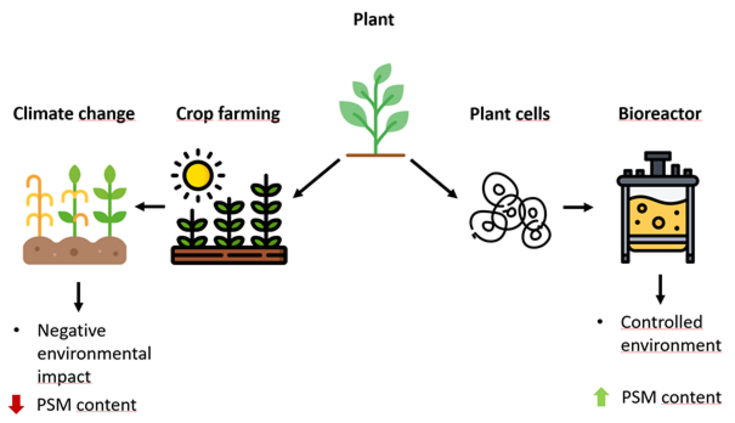Cultured Metabolites – A plant cell culture approach for the scalable production of complex small molecules
SUPERVISOR: Johannes BUYEL
PROJECT ASSIGNED TO: Lukas LEIBETSEDER
Many plant-derived secondary metabolites (PSM) exhibit substantial therapeutic properties, including anti-inflammatory, antitumor, antimicrobial, and analgesic effects. The traditional method of obtaining these valuable compounds involves the cultivation and harvesting of specific crops, followed by extraction and purification processes [1]. However, this approach faces several challenges, including environmental impact on farming, resource-intensive farming, and environmentally harmful purification practices [2,3]. Since some secondary metabolites are classified by the WHO as essential medicine, it is important to find a reliable process, capable of addressing these problems [4].
Plant suspension culture offers a compelling alternative to traditional crop farming to produce pharmaceutically important secondary metabolites [5]. Unlike traditional farming, plant suspension cultures provide a highly controlled environment concerning internal and external factors influencing the process, ensuring consistent production of products. Moreover, plant suspension cultures can be scaled up in bioreactors, making it feasible to produce large quantities without the need for extensive agricultural land [6].
Utilizing the native host of the target product also provides an advantage over recombinant systems, since the biosynthetic pathway does not need to be engineered and introduced into the heterologous system [7]. Traditionally, the production of secondary metabolites is induced by a process called elicitation, which describes the addition of biotic or abiotic compounds inducing stress in the plant cells. In turn, defence mechanisms are triggered, and secondary metabolites are produced as a response [5]. This process can increase yields up to 2230-fold [8]. However, since this is an unspecific stress response, multiple pathways will be activated. For some secondary metabolites, elicitation cannot even induce production in plant cell culture, since differentiated cells are required for production [9]. Thus, a more specific response would not only optimize the carbon flux, which results in a more resource effective process, but also potentially enable the production in the first place.
Purification processes for secondary metabolites mainly rely on the use of organic solvents [10]. As these compounds pose a potential risk to human health and contribute to significant resource allocation for waste treatment, future processes should focus on developing an organic solvent free procedure [11].
The aim of this thesis is to successfully identify regulating elements and use them to trigger the production of target products in plant suspension cell culture. The plant native to the target secondary metabolite will be engineered to grow in suspension culture and used as host cell for the production process. Subsequently, the media composition and production parameters will be optimized using a design of experiment (DoE) approach. Finally, an organic solvent-free purification of the target secondary metabolite will be developed and implemented into the final production process.

Figure 1: Graphical abstract for project "Cultured Metabolites", showcasing potential strategies for plant secondary metabolite (PSM) production. Figure created using icons from flaticon.com
References
[1] Schläger S, Dräger B. Exploiting plant alkaloids. Curr Opin Biotechnol 2016;37:155–64. doi.org/10.1016/j.copbio.2015.12.003.
[2] Kundrátová K, Bartas M, Pečinka P, Hejna O, Rychlá A, Čurn V et al. Transcriptomic and Proteomic Analysis of Drought Stress Response in Opium Poppy Plants during the First Week of Germination. Plants (Basel) 2021;10(9). doi.org/10.3390/plants10091878.
[3] McAlister S, Ou Y, Neff E, Hapgood K, Story D, Mealey P et al. The Environmental footprint of morphine: a life cycle assessment from opium poppy farming to the packaged drug. BMJ Open 2016;6(10):e013302. doi.org/10.1136/bmjopen-2016- 013302.
[4] WHO. Left behind in pain: extent and causes of global variations in access to morphine for medicinal use and actions to improve safe access; 2023.
[5] Ochoa-Villarreal M, Howat S, Hong S, Jang MO, Jin Y-W, Lee E-K et al. Plant cell culture strategies for the production of natural products. BMB Rep 2016;49(3):149–58. doi.org/10.5483/bmbrep.2016.49.3.264.
[6] Wilson SA, Roberts SC. Recent advances towards development and commercialization of plant cell culture processes for the synthesis of biomolecules. Plant Biotechnol J 2012;10(3):249–68. doi.org/10.1111/j.1467-7652.2011.00664.x.
[7] Dziggel C, Schäfer H, Wink M. Tools of pathway reconstruction and production of economically relevant plant secondary metabolites in recombinant microorganisms. Biotechnol J 2017;12(1). doi.org/10.1002/biot.201600145.
[8] Giri CC, Zaheer M. Chemical elicitors versus secondary metabolite production in vitro using plant cell, tissue and organ cultures: recent trends and a sky eye view appraisal. Plant Cell Tiss Organ Cult 2016;126(1):1–18. doi.org/10.1007/s11240-016-0985- 6.
[9] Facchini PJ, Bird DA. Developmental regulation of benzylisoquinoline alkaloid biosynthesis in opium poppy plants and tissue cultures. In Vitro Cell.Dev.Biol.-Plant 1998;34(1):69–79. doi.org/10.1007/BF02823126.
[10] KOÇANCI FG, NİĞDELİOĞLU DOLANBAY S, ASLIM B. Comparison of three different protocols of alkaloid extraction from Glaucium corniculatum plant. International Journal of Secondary Metabolite 2022;9(1):43–51. doi.org/10.21448/ijsm.980171.
[11] Sheldon RA. The greening of solvents: Towards sustainable organic synthesis. Current Opinion in Green and Sustainable Chemistry 2019;18:13–9. doi.org/10.1016/j.cogsc.2018.11.006.
